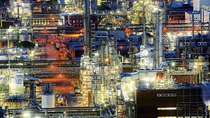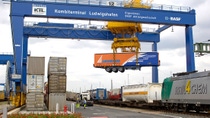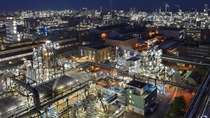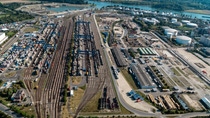Sustainability
Reducing emissions along the value chain
At our production sites and along the value chain with our partners, we work continuously to reduce the greenhouse emissions from our business activities.
Chemical production requires a large amount of energy and some processes also create greenhouse gases as by-products. Our aim is to continuously reduce the greenhouse gas emissions resulting from the generation of energy in power plants and from the production processes. Our experts are constantly working on further improving the processes and setup of our installations.
Moreover, we encourage our employees to make an active contribution to increase our efficiency by constantly running suggestion scheme campaigns at various BASF sites. Each idea that is implemented results in a financial reward that is proportional to the amount of cost and greenhouse gas savings. In this way, we achieve an emission reduction of several thousand tons of CO2 equivalent each year.
As a result, we have already achieved a great deal on the way towards greater climate protection. We have been able to reduce absolute emissions in the chemical business by 48.1 percent compared with 1990. The reduction per metric ton of sales product was in fact 72.1 percent.

Adapted figure from the BASF Online Report 2020
Nitrous oxide decomposition catalysts
The use of nitrous oxide (N2O) decomposition catalysts is an important lever for emission reduction in our production. We have installed our own N2O decomposition catalysts in all plants where nitrous oxide is created as a by-product.
Sustainable energy supply for production sites
Energy is one of the main cost drivers of production. Therefore an efficient energy generation and use of energy in the production is very essential for BASF. The Energy Verbund and combined heat and power plants are of major importance in that respect.
We are continuously exploring the use of renewable energies. The focus here is on the purchase of electricity. Our research also contributes to increasing the efficiency of technologies for the use of renewable energy sources.
Energy Verbund

Our Verbund concept which is applied at all major sites makes an important contribution to energy efficiency by linking our production and energy demand. Waste heat from production processes is captured to be used as energy in other production plants. Thanks to the Energy Verbund, BASF saved in 2020 around 18.7 million MWh per year, equal to an annual reduction in CO2 emissions of 3.8 million metric tons. 45 percent of the steam consumption of BASF group is covered here by use of excess process heat and of the energetic use of by-products from production. The Verbund is one of our prime strengths in ensuring the efficient use of resources. Therefore, it is a key success factor for BASF in global competition and environmental protection.
Combined heat and power

We increasingly use combined heat and power (CHP) plants to generate both electricity and steam. Such cogeneration plants are an extremely effective means of supplying energy and, with an overall fuel efficiency of almost 90 percent, are the front-runners among energy conversion methods suitable for use on an industrial scale. Worldwide our sites are supplied by more than 25 gas turbine plants in combined heat and power mode, the majority of them operated by BASF. By using CHP technology, we are able to meet around 70 percent of BASF’s electricity demand and saved about 12.0 million MWh of fossil fuels in 2020, compared to conventional electricity and steam generation. This corresponds to 2.4 million metric tons worth of prevented carbon emissions.
Energy Management, Energy Efficiency and ISO 50001 at BASF

As a company with a high energy demand, we have been paying attention to the efficient use of energy for decades already. With our comprehensive energy management we continuously analyze, improve and review our energy performance. We achieved our goal of introducing certified energy management systems according to DIN EN ISO 50001 at all relevant production sites by the end of 2020. The selection of relevant sites is determined by the amount of primary energy used and local energy prices. The relevant sites represent 90 percent of BASF’s primary energy demand. At the end of 2020, 81 sites were certified worldwide, representing 91 percent of our primary energy demand.
You can find a leaflet on “Energy Management, Energy Efficiency and ISO 50001 at BASF” here. Certificates are available on request.
a Relevant sites are selected based on the amount of primary energy used and local energy prices; does not yet include the polyamide business acquired from Solvay.
Raw materials and suppliers
The close cooperation between partners along the entire value chain is a major factor in lowering greenhouse gas emissions, because often opportunities for reducing emissions can only be achieved as a joint effort. 52 million metric tons of greenhouse gas emissions were generated in the production of the raw materials, precursors, energy sources, services and capital goods that BASF purchased in 2020. We work with carefully selected raw material suppliers on specific projects looking at solutions contributing to reduce these emissions.
Environmental protection, occupational safety and social standards, in addition to economic criteria, are part of the assessment of new and existing supplier relationships and are an integral part of our conditions of purchase.
Transport

Intermodal transport is an important lever to reducing emissions in logistics. Transporting goods by rail instead of by road reduces CO2 emissions by up to 65 percent. BASF uses intermodal transport at its major production sites at Ludwigshafen, Schwarzheide and Antwerp.


.jpg)
